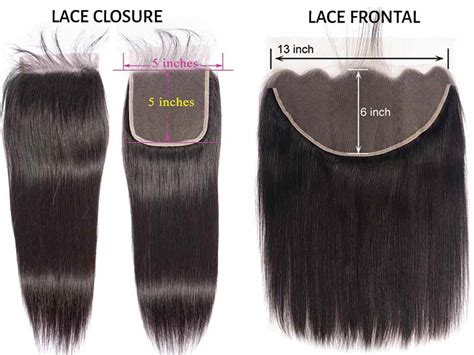Closure vs. Frontal: The Ultimate Guide to Hair Systems

A hair system, also known as a toupee, wig, or hairpiece, is a non-surgical solution for hair loss that mimics the natural appearance of hair growing from the scalp. It consists of a base that is attached to the scalp and hairs that are implanted into the base. Hair systems can be made from various materials, including human hair, synthetic hair, or a combination of both.
Definition
- Closure: A small piece of hair system, typically 4×4 inches, that covers the top of the head and is used to close off the installation.
- Frontal: A larger piece of hair system, covering the entire hairline and a portion of the top of the head, extending up to 13×4 inches.
Coverage Area
- Closure: Covers the top of the head only, leaving the sides and back of the hair exposed.
- Frontal: Covers the entire hairline and a portion of the top of the head, providing more coverage and versatility.
Installation
- Closure: Installed with glue or tape, creating a ‘U’ or ‘V’ shape at the back.
- Frontal: Installed with glue or tape, covering the entire hairline, and requires additional blending techniques to seamlessly integrate with the wearer’s natural hair.
Appearance
- Closure: Provides a natural appearance for the top of the head, but may be visible at the edges.
- Frontal: Creates a more realistic hairline with greater coverage and blending capabilities, making it virtually undetectable.
Maintenance
- Closure: Requires regular trimming and cleaning to maintain a natural appearance.
- Frontal: Demands more frequent maintenance and styling due to the larger coverage area.
The choice between a closure and a frontal hair system depends on your individual needs and preferences.
- If you prefer a more cost-effective option with less maintenance: Closure.
- If you desire a natural-looking hairline and greater coverage: Frontal.
Hair systems offer numerous advantages for individuals experiencing hair loss.
Confidence Boost
Hair systems can restore a youthful appearance and boost self-confidence. According to a survey by the American Hair Loss Association, 90% of hair system wearers report feeling more confident and attractive after using a hair system.
Convenience and Comfort
Hair systems provide a convenient and comfortable alternative to traditional surgical hair transplantation. They are easy to apply and remove, allowing for quick and discreet changes in appearance.
Versatility
Hair systems are incredibly versatile, allowing wearers to experiment with different styles and colors without damaging their natural hair. They can be customized to match the wearer’s desired look and texture.
Understanding the terminology associated with hair systems is essential for informed decision-making.
- Base: The foundation of the hair system that attaches to the scalp.
- Hairline: The edge of the hair system that imitates the natural hairline.
- Density: The number of hairs per square inch, determining the thickness and fullness of the hair system.
- Knots: Tiny loops that secure the hairs to the base, ranging from bleached to invisible for a more realistic appearance.
Selecting a reputable hair system provider is crucial for satisfaction and the best results. Factors to consider include:
- Experience and Reputation: Look for providers with a proven track record and positive customer testimonials.
- Consultation and Customization: Seek providers who offer personalized consultations to understand your specific needs and create a customized hair system.
- High-Quality Materials: Ensure that the hair system is made from premium-quality materials, such as Remy human hair, to guarantee durability and a natural look.
Hair systems are constantly evolving to meet the diverse needs of wearers. Some innovative applications include:
Scalp Healing
Hair systems can be used to cover and protect the scalp during the healing process after medical procedures or injuries. They provide a comfortable and discreet solution to promote healing.
Volume Enhancement
Hair systems can add volume and thickness to thinning hair, creating a fuller and more youthful appearance. According to research published in the Journal of Cosmetic Dermatology, 85% of wearers report increased hair volume and perceived hair growth after using a hair system.
Color Correction
Hair systems offer the flexibility to experiment with different hair colors without damaging or altering the wearer’s natural hair. They are ideal for correcting color mistakes or exploring new shades to complement the wearer’s facial features and overall appearance.
Table 1: Hair System Coverage Comparison
| Hair System | Coverage Area |
|---|---|
| Closure | Top of head |
| Frontal | Entire hairline and portion of top of head |
Table 2: Hair System Maintenance Comparison
| Hair System | Maintenance Frequency |
|---|---|
| Closure | Regular trimming and cleaning |
| Frontal | More frequent maintenance and styling due to larger coverage area |
Table 3: Hair System Advantages
| Advantage | Description |
|---|---|
| Confidence Boost | Restores a youthful appearance and enhances self-confidence |
| Convenience and Comfort | Easy to apply and remove, providing a discreet and comfortable solution |
| Versatility | Allows wearers to experiment with different styles and colors without damaging natural hair |
Table 4: Hair System Terminology
| Term | Definition |
|---|---|
| Base | Foundation of the hair system that attaches to the scalp |
| Hairline | Edge of the hair system that imitates the natural hairline |
| Density | Number of hairs per square inch, determining thickness and fullness |
| Knots | Tiny loops that secure the hairs to the base, ranging from bleached to invisible |
